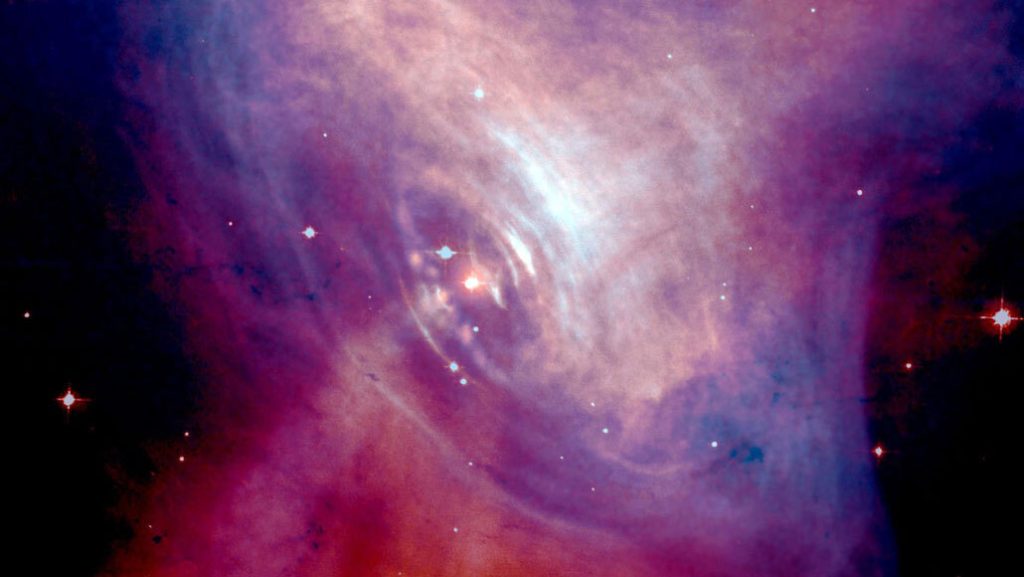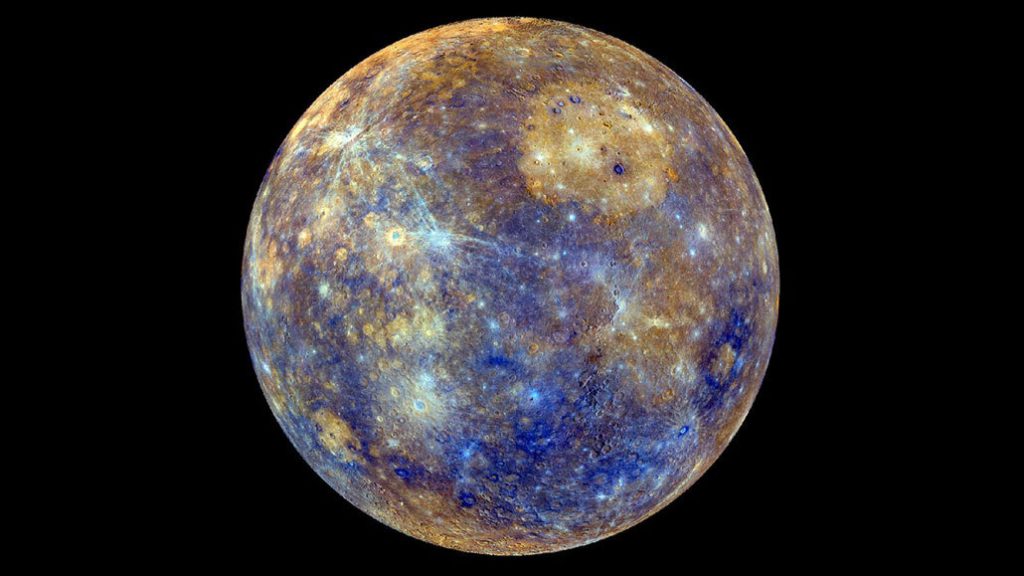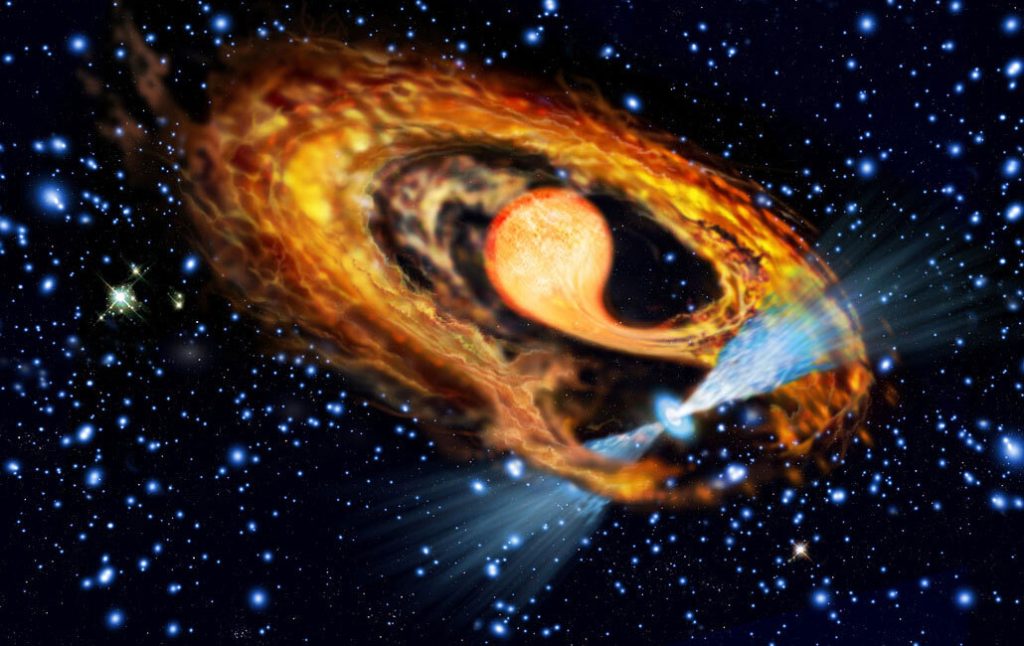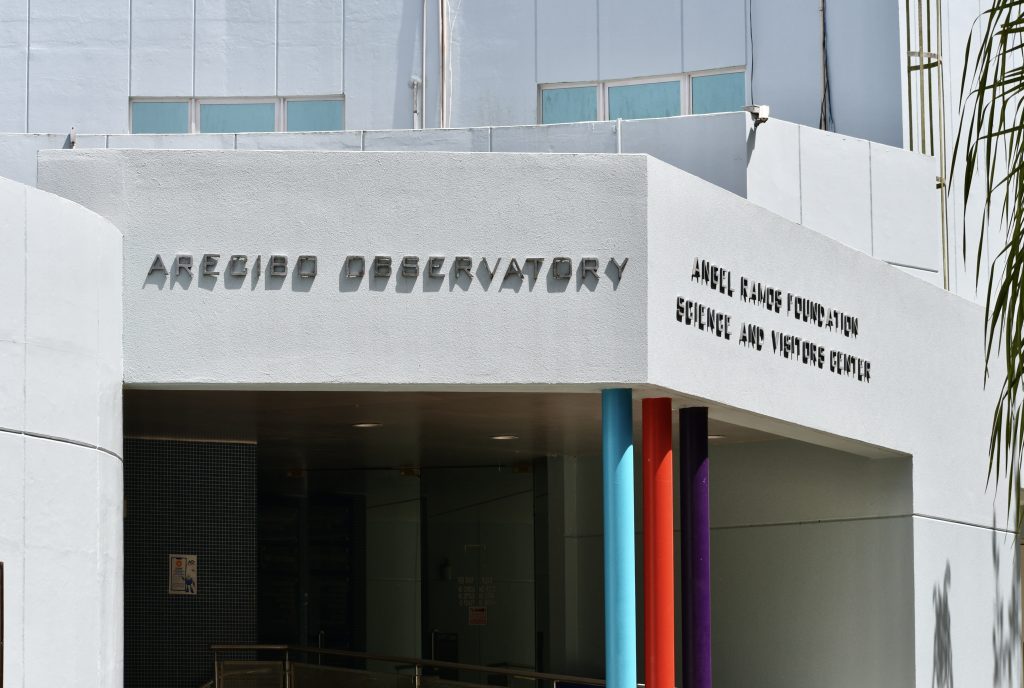


Source left to right: 1. NASA, HST, ASU, J. HESTER ET AL.; X-RAY: NASA, CXC, ASU, J. HESTER ET AL. 2. ESA, FRANCESCO FERRARO/BOLOGNA ASTRONOMICAL OBSERVATORY. 3. NASA, JHUAPL, CARNEGIE INSTITUTION OF WASHINGTON
Together We Can Make A Difference
Arecibo Legacy
UCF became the custodian of the Arecibo Observatory in 2018. The Arecibo Observatory was the largest, most powerful, and sensitive single radio dish telescope in the world. On December 1, 2020 the support system of the telescope collapsed, and without the main instrument that provided competitive science discoveries, it was very difficult for NSF to continue its operations. On August 14, 2023 the Arecibo Observatory facility was closed to be repurposed as a STEM Education Center starting in early 2024.
UCF felt the responsibility to give a new home to the former Arecibo (AO) scientists so they can continue with their research and/or start new projects with a bright new beginning at the Florida Space Institute at UCF.
FSI now hosts the AO Legacy! We encourage you to explore the gift of giving to a specific Arecibo Observatory former scientist and/or a specific research project you are interested in. The AO Legacy includes research on Astronomy, Planetary, and Atmospheric Sciences. This gift will help them continue with their research efforts and/or other projects, and initiatives related to AO Legacy.
Thanks to your gifts, the scientists listed below will be able to advance humanity’s understanding of the world around us and achieve new research breakthroughs – fueling humanity’s expansion into space.

Instructions on how to donate:
Please follow the link or QR code at the bottom of the page and fill out the necessary information.
You must write “AO Legacy” in the explanation line for the donation or it will not be received properly. If you would like to donate to a specific researcher, you may write: “AO Legacy – ‘Researchers Name’” and it will be gifted to the specific researcher.
Below you will find a short description of some of the researcher’s specialties so you may learn about the different impacts they each have on the space industry!
1. Astronomy Science
- Researchers in this Category:
- Anish Roshi Damodaran, PhD
- Dr. Anish Roshi graduated with an engineering degree in electronics and communications from the University of Kerala. In 1989, he joined the Tata Institute of Fundamental Research (TIFR), National Center for Radio Astrophysics, Pune as a Research Associate/Scientific Officer. At TIFR, he completed his Ph.D (Physics) specializing in Radio Astronomy (1999) and was appointed as a member of the faculty.
He was a Jansky postdoctoral fellow at the National Radio Astronomy Observatory (NRAO), USA between 2000 and 2002. On completion of the post doctoral fellowship, Dr Roshi joined the Raman Research Institute (RRI), Bangalore. While at RRI his biggest contribution was in leading a team of engineers in successfully designing and building a digital receiver for the Murchison Widefield Array, located at Western Australia.
In 2010, Dr. Roshi moved to the National Radio Astronomy Observatory (NRAO), USA. At NRAO, he was the System Architect and Project Scientist for the Versatile Astronomical Spectrometer that was built for the Green Bank Telescope (GBT). He was also the System Architect for the Phased Array Feed (PAF) project. PAFs are specialized feed to increase the field of view of a radio telescope.
- Dr. Anish Roshi graduated with an engineering degree in electronics and communications from the University of Kerala. In 1989, he joined the Tata Institute of Fundamental Research (TIFR), National Center for Radio Astrophysics, Pune as a Research Associate/Scientific Officer. At TIFR, he completed his Ph.D (Physics) specializing in Radio Astronomy (1999) and was appointed as a member of the faculty.
- Benetge Perera, PhD
- Dr. Ben Perera is a radio astronomer who is interested in all manifestations of neutron stars. He predominantly conducts research with radio pulsars and is trying to use them to probe fundamental physics. He has expertise in high-precision pulsar timing, gravitational wave detection, pulsar searching, emission physics, pulsar dynamics, and double neutron stars. He has used the 305-m Arecibo telescope for a variety of his projects. Dr. Ben has been actively working with the NANOGrav to succeed in the primary goal of detecting low-frequency gravitational waves in the nanohertz band, and the Arecibo telescope was one of his group’s main instruments. With the enormous sensitivity of the telescope, more than half of NANOGrav’s sensitivity to gravitational waves was provided by Arecibo data. His research group recently published tantalizing results on gravitational waves. The NANOGrav data plays a significant role in the international effort to detect gravitational waves through the International Pulsar Timing Array (IPTA) experiment. He is currently interested in pulsar searching and was a part of large-scale pulsar surveys conducted at Arecibo – PALFA and AO327; more than 300 pulsars have been discovered by combining these two surveys alone. He is also interested in Fast Radio Bursts, which allow us to reveal mysteries in the universe.
- Dr. Ben Perera is a radio astronomer who is interested in all manifestations of neutron stars. He predominantly conducts research with radio pulsars and is trying to use them to probe fundamental physics. He has expertise in high-precision pulsar timing, gravitational wave detection, pulsar searching, emission physics, pulsar dynamics, and double neutron stars. He has used the 305-m Arecibo telescope for a variety of his projects. Dr. Ben has been actively working with the NANOGrav to succeed in the primary goal of detecting low-frequency gravitational waves in the nanohertz band, and the Arecibo telescope was one of his group’s main instruments. With the enormous sensitivity of the telescope, more than half of NANOGrav’s sensitivity to gravitational waves was provided by Arecibo data. His research group recently published tantalizing results on gravitational waves. The NANOGrav data plays a significant role in the international effort to detect gravitational waves through the International Pulsar Timing Array (IPTA) experiment. He is currently interested in pulsar searching and was a part of large-scale pulsar surveys conducted at Arecibo – PALFA and AO327; more than 300 pulsars have been discovered by combining these two surveys alone. He is also interested in Fast Radio Bursts, which allow us to reveal mysteries in the universe.
- Periasamy Manoharan (P.K. Manoharan), PhD
- The major part of Manoharan’s scientific career has been dedicated to the study of a wide range of solar magnetic activity phenomena, through flares and coronal mass ejections (CMEs) to the formation of the solar wind. He has also studied the turbulence of the interstellar medium based on pulsar observations. Whenever possible, he has also made observations of the plasma tails of comets using the remote-sensing scintillation technique.
Manoharan developed a unique ‘first of its kind’ method to determine the speed and other physical properties of the solar wind using interplanetary scintillation measurements from the Ooty Radio Telescope. Space weather is becoming an increasingly important component in the day-to-day operation of several technological systems and the key issue is the difficulty of predicting the occurrence time and location of strong solar eruptions, i.e., those leading to the high impact space-weather disturbances at the near-Earth environment. Moreover, the space weather program involves the understanding of the complex, nonlinear nature of the solar-terrestrial system, and its related ability to forecast the effects of this connection on Earth. The interdisciplinary solar-terrestrial research thus requires the full realization of the potential of the tools designed to mathematically explore complex nonlinear systems, researchers from the fields of mathematics, information science, computer science, machine learning, and data mining are experienced with such sophisticated methods and apply them to challenging new problems
- The major part of Manoharan’s scientific career has been dedicated to the study of a wide range of solar magnetic activity phenomena, through flares and coronal mass ejections (CMEs) to the formation of the solar wind. He has also studied the turbulence of the interstellar medium based on pulsar observations. Whenever possible, he has also made observations of the plasma tails of comets using the remote-sensing scintillation technique.
- Anish Roshi Damodaran, PhD
2. Planetary Science
- Researchers in this Category:
- Flaviane Vendetti, PhD
- Dr. Flaviane Venditti joined the Florida Space Institute (FSI) in August 2023 after working for more than six years at the Arecibo Observatory, where she was acting as the head of the Planetary Radar group since April of 2021. She started her scientific career as a Bachelor in Physics/Astronomy at the University of Sao Paulo working with optical observations and polarimetry. She was also interested in celestial mechanics and space missions, which led her to pursue a Master’s (2009) and PhD (2013) degree focused on astrodynamics. She was a postdoctoral scientist in Montreal for 2.5 years working with dynamics of asteroid deflection at McGill University, Canada. One of the many reasons that brought her to Arecibo was the possibility to work with radar observations and to be actively part of the planetary defense community, which was directly related to her previous projects. Her current research interests include radar observations, characterization of near-Earth objects (NEOs), orbital dynamics, and asteroid deflection techniques.
- Dr. Flaviane Venditti joined the Florida Space Institute (FSI) in August 2023 after working for more than six years at the Arecibo Observatory, where she was acting as the head of the Planetary Radar group since April of 2021. She started her scientific career as a Bachelor in Physics/Astronomy at the University of Sao Paulo working with optical observations and polarimetry. She was also interested in celestial mechanics and space missions, which led her to pursue a Master’s (2009) and PhD (2013) degree focused on astrodynamics. She was a postdoctoral scientist in Montreal for 2.5 years working with dynamics of asteroid deflection at McGill University, Canada. One of the many reasons that brought her to Arecibo was the possibility to work with radar observations and to be actively part of the planetary defense community, which was directly related to her previous projects. Her current research interests include radar observations, characterization of near-Earth objects (NEOs), orbital dynamics, and asteroid deflection techniques.
- Sean Marshall, PhD
- Dr. Sean Marshall specializes in using data from radar and other observations of near-Earth asteroids to find their shapes and other physical properties. He is a member of the science team for JAXA’s upcoming DESTINY+ mission to 3200 Phaethon.
Sean has a Ph.D. in Astronomy from Cornell University and Bachelor’s degrees in Physics and Astronomy (Earth and Space Exploration) from Arizona State University. He joined FSI in August 2023, previously working in the solar system radar group at Arecibo Observatory.
- Dr. Sean Marshall specializes in using data from radar and other observations of near-Earth asteroids to find their shapes and other physical properties. He is a member of the science team for JAXA’s upcoming DESTINY+ mission to 3200 Phaethon.
- Marin Ferrais, PhD
- Dr. Ferrais joined the Arecibo Observatory in December 2023 as a postdoctoral researcher. They have a Master in astrophysics from the University of Liège in Belgium and a Ph.D. from the Laboratoire d’Astrophysique de Marseille in France during which they studied the largest main-belt asteroids using shape modelling. Their focus is now on the study of near-Earth asteroids by combining lightcurves, polarimetry, and radar observations. They are working on the shape model of 1994 AW1, a binary near-Earth asteroid observed at Arecibo in 2015 and a former a candidate for the NASA mission Dart. Dr. Ferrais is also involved in a project aiming at defining a new method to determine rapidly and reliably the size of newly discovered near-Earth asteroids, which is important for planetary defense purposes.
- Dr. Ferrais joined the Arecibo Observatory in December 2023 as a postdoctoral researcher. They have a Master in astrophysics from the University of Liège in Belgium and a Ph.D. from the Laboratoire d’Astrophysique de Marseille in France during which they studied the largest main-belt asteroids using shape modelling. Their focus is now on the study of near-Earth asteroids by combining lightcurves, polarimetry, and radar observations. They are working on the shape model of 1994 AW1, a binary near-Earth asteroid observed at Arecibo in 2015 and a former a candidate for the NASA mission Dart. Dr. Ferrais is also involved in a project aiming at defining a new method to determine rapidly and reliably the size of newly discovered near-Earth asteroids, which is important for planetary defense purposes.
- Luisa Fernanda Zambrano Marin, M.S.
- Luisa Fernanda specializes in near-Earth Asteroids using the Arecibo Planetary Radar System, focusing on fast rotating objects, Binary Systems, and asteroid Shape modeling. She curates a comprehensive Arecibo Planetary Radar observation repository, ensuring community access. Her expertise also encompasses academia-industry relations, teacher and K-12 student engagement, and curriculum development. Originally from Colombia, Luisa Fernanda moved to Puerto Rico during her teenage years. She earned an Applied Physics degree and conducted research for the Kepler Mission in Italy with the Vatican Observatory Group. During her Masters in Space Studies at the International Space University, she worked on Juno, Voyager 1 and 2 Missions, and explored the application of space technologies for heritage site preservation. Luisa Fernanda managed the development of the Cristina Torres-Memorial Astronomical Observatory, fostering educational initiatives at the University of Texas at Brownsville. After returning to Puerto Rico, she advised businesses in the emerging space economy and organized events to integrate Puerto Rico into the space industry. She established the Arecibo Observatory Space Academy, guiding over 350 local students in Human Space Settlement studies. Following the Arecibo Observatory’s collapse, she served as Co-Chair of the Salvaging Survey Committee, demonstrating her resilience and leadership.
- Flaviane Vendetti, PhD
3. Space and Atmospheric Sciences
- Researchers in this Category:
- Pedrina Terra dos Santos, PhD
- For over seventeen years, Dr. Terra served as Senior Scientist at the Space and Atmospheric Sciences group at Arecibo Observatory (AO). There, she led the Arecibo Optical Laboratory (AOL). After the AO’s closure, Dr. Terra relocated several optical and radar instruments to the units of the Climate Center for Open Research and Education (CCORE) on the island of Culebra, Puerto Rico. This initiative supported by FSI/UCF is crucial to keep adding to the unique database from AO, significantly impacting the scientific community in future research involving long-term trends. Dr. Terra is the Lead Scientist of CCORE. Up to today, CCORE has supported different proposals in different areas of aeronomy and Space and Atmospheric Sciences. The research areas involve wave propagation, ionospheric irregularities, aerosol, meteor influx, and others. These have significant implications for modern technologies sensitive to the conditions in the near-Earth space environment and the effects of climate change. The ability to model and prognostic future changes in the climate that may impact these technologies hinges upon detailed knowledge and understanding of the Earth’s atmosphere as a coupled system. Thus, it is crucial to be able to observe different regions of the Earth’s atmosphere.
- For over seventeen years, Dr. Terra served as Senior Scientist at the Space and Atmospheric Sciences group at Arecibo Observatory (AO). There, she led the Arecibo Optical Laboratory (AOL). After the AO’s closure, Dr. Terra relocated several optical and radar instruments to the units of the Climate Center for Open Research and Education (CCORE) on the island of Culebra, Puerto Rico. This initiative supported by FSI/UCF is crucial to keep adding to the unique database from AO, significantly impacting the scientific community in future research involving long-term trends. Dr. Terra is the Lead Scientist of CCORE. Up to today, CCORE has supported different proposals in different areas of aeronomy and Space and Atmospheric Sciences. The research areas involve wave propagation, ionospheric irregularities, aerosol, meteor influx, and others. These have significant implications for modern technologies sensitive to the conditions in the near-Earth space environment and the effects of climate change. The ability to model and prognostic future changes in the climate that may impact these technologies hinges upon detailed knowledge and understanding of the Earth’s atmosphere as a coupled system. Thus, it is crucial to be able to observe different regions of the Earth’s atmosphere.
- Christiano Garnett Marques Brum, PhD
- Dr. Christiano Brum started his science career as part of the Brazilian Antarctic Program. For 10 years he participated in several Antarctic expeditions collecting data on the upper atmosphere and thermosphere. His PhD thesis was focused on high-and-mid latitudes cosmic noise absorption by the ionospheric D-region. He was a National Institute of Space Research (INPE), Utah State University, and Cornell University postdoctoral fellow. On completion of his last post-doctoral fellowship, Dr. Brum assumed the Arecibo Observatory’s Space and Atmospheric Science department leadership (2011). Dr. Brum’s relationship with FSI-UCF started in 2017 when he was part of the FSI-UAGM-YEN team that won the NSF cooperative agreement to manage Arecibo Observatory, where he became the Deputy Director of Science Operations until the closeout of the site. Currently, Dr. Brum is based in Orlando and is part of the Florida Space Institute team as a visiting research professor. Dr. Brum’s current work is on studies of the ionosphere, thermosphere, and magnetosphere (ITM) regions by combining information from different probing instruments (optical and radio) which allow unique insights into fundamental plasma processes and incredible diagnoses of the upper atmospheric conditions during different geophysical conditions and also for climate changes.
- Pedrina Terra dos Santos, PhD

